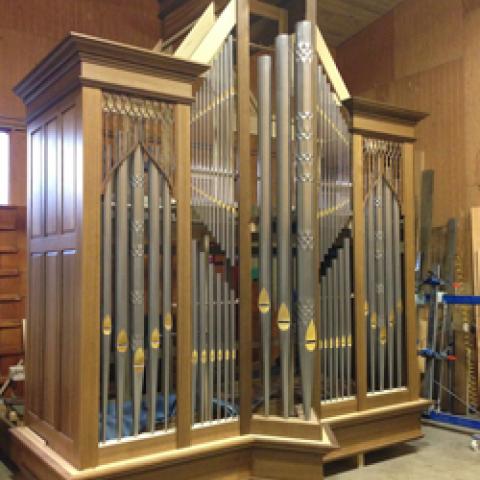
Martin Pasi, Organbuilder, held an open house December 18, 2005 in his Roy, Washington shop to showcase the new organ for Church of the Ascension, Dallas, Texas. Opus 16 is an innovative and well-proportioned instrument of two manuals and pedal that features a full ensemble, including Cornet stops on the main division, with a rich palette of accompanimental stops on the secondary manual.
Susan Ferré was consultant for the project and demonstrated the organ at the open house. These events are well received in the Seattle-Tacoma area, and Ms. Ferré became well known and much admired for her role on the organ faculty of Pacific Lutheran University, following the untimely death of James Halloway several years ago.
A special treat for those who attended the open house was the presentation of a magnificent antique Italian organ of six stops, built by Domenico Traeri of Bologna and dated 1742. Martin Pasi and a former associate Robert Wech restored the organ to playing condition so that its antique characteristics remain charming and musical in every way. The two organs were in separate rooms in the Pasi shop, so that visitors could listen to formal demonstrations or try the organs out for themselves. This was a musical treat indeed! Martin Pasi set up the open house as an informal affair, and people were encouraged to try the organs whenever they were available. Music was provided and the afternoon event featured music on both organs, non-stop.
There is nothing quite so fine as a musical afternoon in a pipe organ shop, and this event seemed to top them all. All the Pasi organs can be investigated in detail at
—Herbert L. Huestis
GREAT
16' Bourdon
8' Principal
8' Suavial
8' Rohrfloete
4' Octave
4' Spitzfloete
3' Quint
2' Octave
13?5' Tierce
Mixture IV
SWELL
8' Gamba
8' Celeste
8' Bourdon
4' Principal
2' Gemshorn
16' Bassoon
8' Trumpet
PEDAL
16' Subbass (Gt)
8' Octave (Gt)
16' Bassoon (Sw)
8' Trumpet (Sw)
Normal Couplers
Tremulant
Compass 58/30




